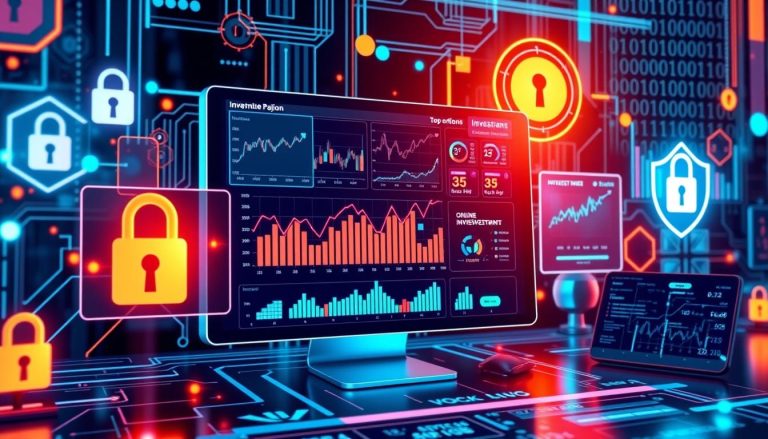In today’s digital world, the idea of a “digital detox” is becoming more popular. It’s a choice to step away from screens and digital distractions for a while. This helps us feel better, focus better, and connect more with the world around us.
Our use of technology is growing, and it’s time to think differently about it. Almost 65% of people feel stressed or anxious when they’re always online. But, over 70% say they feel more focused and productive after taking a break from digital devices.
There are many benefits to taking a digital detox. About 80% of people feel more connected with others after doing it. And, more than 60% sleep better when they don’t use screens before bed. Around 75% find new hobbies and interests, showing how it can improve our lives.
Key Takeaways
- Digital detox can reduce stress and anxiety by disconnecting from digital devices
- Improved focus and productivity are common benefits of engaging in a digital detox
- Digital detox can enhance presence and connection in relationships
- Better sleep quality is often reported after implementing a digital detox before bedtime
- Rediscovering old passions and hobbies is a common outcome of a digital detox
Understanding Digital Detox in Modern Life
In today’s fast-paced world, digital detox is a big topic. It means taking a break from devices like phones and laptops. This lets people step away from digital noise and connect with the real world.
What Constitutes a Digital Detox?
Digital detox can mean different things to different people. It could be a total tech ban or just setting aside tech-free times and places. How long you do it depends on what you want to achieve.
Why Digital Detoxing Matters Today
Too much screen time is a worry for many. Digital detoxing helps keep a balance in our lives. It helps us deal with problems like sleep issues, less face-to-face time, and mental health concerns.
The Impact of Technology Overuse
Too much tech can harm our focus, understanding of emotions, and social skills. It can lead to addiction, loneliness, and sleep problems, affecting our mental health. Harvard Health notes that screen light can mess with our sleep.
Trying a tech sabbatical or media detox can change lives. It helps people find more time, improve relationships, and feel better overall.

The Science Behind Screen Time and Mental Health in Digital Detox
Research shows that too much screen time hurts mental health, especially for young people. It can cause anxiety, depression, and feelings of not being good enough.
Social media sites like Instagram and Facebook are addictive. They make us feel bad about ourselves and worry about missing out. This can lower our self-esteem and stress levels, making us unhappy overall.
But, cutting down on screen time helps our mental health. It can make us sleep better, focus more, and build stronger relationships. It also makes us happier with our lives.
“Reductions in digital media use were shown to improve mental health outcomes in adults in some intervention studies.”
A digital detox and being more mindful with technology can greatly improve our mental health. By setting limits, making tech-free areas, and choosing to disconnect, we can clear our minds and improve our lives.

Teenagers are especially affected by too much screen time. Studies link it to depression, ADHD, and other problems. The pandemic has made this worse, with teens’ screen time going up by 52%.
Understanding the link between screen time and mental health is key in today’s digital world. By being a digital minimalist and using technology mindfully, we can take back our well-being. This leads to a healthier, more balanced life in the digital age.
Key Benefits of Digital Detox
In today’s world, taking a break from technology can be very beneficial. It helps our minds and bodies feel better. By stepping away from screens, we can think clearer, focus better, and stay healthier.
Improved Mental Clarity and Focus
Too much screen time can make our brains tired and hard to concentrate. Taking a digital detox lets our minds rest and get sharper. This makes us more productive and creative, helping us do things better.
Enhanced Physical Well-being
Being stuck in front of screens can harm our bodies. It can make us sit too much, hurt our eyes, and feel tired. A digital detox helps us move more, sleep better, and feel less stressed. It makes us feel more energetic, stand up straight, and see better.
Better Sleep Quality
The blue light from screens can mess up our sleep. It’s hard to fall asleep and sleep well. Taking a break from screens before bed helps us sleep better. We wake up feeling refreshed and ready to go.
Strengthened Real-world Relationships
Being always connected can hurt our real-life relationships. A digital detox lets us spend more time with people we care about. It helps us build stronger bonds and feel more connected.
By taking digital detoxes, we can clear our minds, feel better physically, sleep better, and connect with others. This approach to tech breaks and device-free living makes life more balanced and fulfilling. It helps us fight internet addiction and live more mindfully.

Social Media’s Impact on Mental Well-being in Digital Detox
Social media is a big part of our lives today. But, being always online can affect our mental health. Sites like Instagram, Facebook, and TikTok show perfect lives that aren’t real.
Many people in the US can’t live without their phones. This addiction can make us feel bad about ourselves. It can lead to depression and anxiety.
Research shows that taking breaks from social media can help. College students who did this felt better and slept better. Even just 30 minutes a day on social media can make us happier.
“A 2020 systematic review linked social media usage to detrimental effects on mental health, including increased anxiety and depression related to social media envy.”
Feeling like we must be online all the time is stressful. It messes with our sleep and hurts our real-life friendships.
It’s good to take breaks from tech and clean up our digital lives. Setting limits on screen time helps us focus better. It makes us feel better and connect with people in real life.

Creating Boundaries for Healthy Tech Use
In today’s world, it’s key to set clear limits on our tech use. This helps us stay balanced. By stepping away from screens, we can think clearer, feel better physically, and connect more with others.
Setting Time Limits
Setting time limits on devices is a smart move. We can choose specific times when screens are off, like during meals or before bed. This helps us focus better and live more mindfully.
Establishing Tech-Free Zones
Creating tech-free areas in our homes and workspaces is also important. For example, making the bedroom screen-free or having no phones at dinner. These spaces help us relax and connect with those around us, away from tech.
Managing Notifications Effectively
Controlling notifications is vital for less tech addiction and healthier use. We can adjust our settings to reduce distractions. This might mean turning off alerts for non-essential apps or removing social media from our main devices.
By using these methods, we can improve our relationship with technology. This leads to more intentional presence and tech addiction recovery. We’ll feel better mentally and live a more balanced life.

Practical Steps to Start Your Digital Detox
Starting a digital detox can change your life. It helps you connect with your mental health and boosts productivity. Here are some steps to help you disconnect and improve your well-being.
First, set clear boundaries for your detox. Decide how long and what you’ll avoid. This helps you stay focused and on track.
Then, plan alternative activities for your time. Try hobbies, reading, exercise, or spending time with family. A balanced routine makes detox easier and more fun.
- Create tech-free zones in your home or workplace to minimize distractions and encourage mindful presence.
- Practice mindfulness techniques to manage cravings for device usage and cultivate a deeper sense of self-awareness.
- Reflect on your detox experience and reassess your relationship with technology. Consider reducing stringent deadlines, implementing personalized limitations, and devising strategies to regulate alerts and device usage.
| Statistic | Insight |
|---|---|
| 50% of individuals may exhibit signs such as difficulty sleeping, increased anxiety, and decreased physical activity, signaling a need for a digital detox. | Recognizing the warning signs of excessive screen time can motivate individuals to take proactive steps towards a digital detox. |
| Setting clear goals results in a 60% higher likelihood of successfully reducing screen time compared to those without defined objectives. | Establishing specific, measurable goals can significantly improve the chances of achieving a successful digital detox. |
| Engaging in non-digital activities like reading or outdoor hobbies can lead to an average decrease of 15% in daily screen time among individuals undergoing a digital detox. | Replacing digital activities with analog alternatives can be an effective strategy to reduce overall screen time during a digital detox. |
By following these steps, you can start a meaningful digital detox. It helps you reconnect with your mental health, boosts productivity, and improves your digital wellbeing.
Maintaining Digital Wellness Long-term
Getting digital wellness is a journey, not a quick fix. To keep a good balance with tech, you need to build lasting habits. This means doing things offline and using tech wisely. By doing these things every day, you can have a good relationship with digital devices and find time for important things.
Building Sustainable Habits
Creating lasting habits is key to digital wellness. Start by setting times when you don’t use devices. This lets you do things offline. Also, clean up your digital space by turning off unwanted notifications and apps. This helps clear your mind from too much online stuff.
Balancing Online and Offline Life
It’s easy to get lost in the online world. But, it’s important to stay connected with the real world. Make time for people, nature, and hobbies that don’t need devices. This helps you build strong relationships and feel better overall.
Mindful Technology Usage
Being mindful with tech is vital for digital wellness. Think about how you use the internet and set limits. Try to make your online habits match your values and goals. This way, you can enjoy tech more and feel more fulfilled.
Keeping digital wellness is a continuous effort. By building good habits, balancing online and offline life, and using tech mindfully, you can have a better relationship with digital devices. This approach helps you do well in the digital world while keeping your well-being first.
Overcoming Digital Detox Challenges
Starting a tech addiction recovery journey is both exciting and scary. People trying to be more present and disconnect from digital stuff face many challenges.
One big problem is feeling lonely or left out when you cut down on screen time. Adults now spend 70% less time with friends than they did 20 years ago. This shows how much tech has changed our social lives.
Feeling bored is another challenge. People used to digital stuff might find it hard to enjoy other activities. But, research says this feeling doesn’t last long. Our minds and bodies get used to being still and present.
- Try new things: Look into hobbies, outdoor activities, or creative projects to replace screen time.
- Focus on the moment: Being mindful helps you enjoy the present, making boredom less of an issue.
- Start small: Begin with short digital detoxes and slowly increase the time as you get more comfortable.
Remember, the hard part of digital detox is often less than you think. Many people feel relieved and happy as they learn to enjoy being present and away from digital noise.
“The key to overcoming digital detox challenges is to approach it with patience, self-compassion, and a willingness to explore alternative ways of engaging with the world around you.”
By being open-minded and committed to your well-being, you can overcome digital detox hurdles. This leads to a healthier, more balanced life with technology.
Conclusion
Digital detox is great for our mental health and productivity. It helps us focus better and sleep well. It also strengthens our connections with the real world.
Even though it can be tough, the benefits are worth it. A balanced use of technology leads to a happier, more mindful life. This boosts our digital wellbeing and productivity.
Having device-free time clears our minds and helps us focus. It also improves our sleep by reducing blue light exposure. This makes our lives more balanced and refreshing.
Digital detox helps us take back control of our tech use. By setting limits and doing offline activities, we create a healthier digital space. This supports our overall well-being.
As technology keeps changing, digital detox is key to a fulfilling life. It helps us find balance in our digital world.






